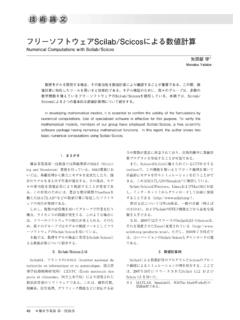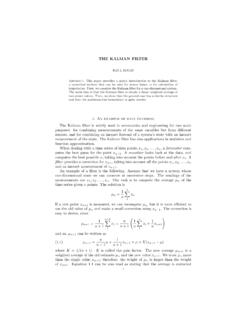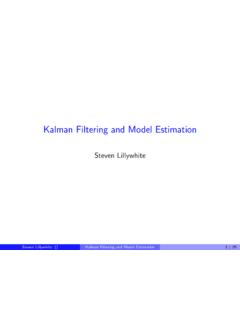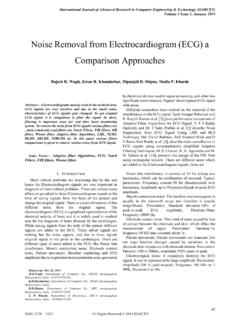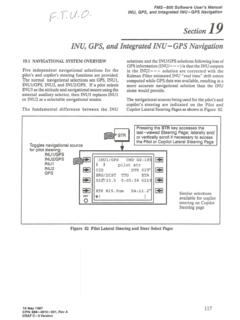Transcription of TUTORIAL Simultaneous Localization and …
1 JUNE 2006 IEEE Robotics & Automation Magazine99 TUTORIALS imultaneous Localizationand mapping : Part I BY HUGH DURRANT-WHYTE AND TIM BAILEYThe Simultaneous Localization and mapping (SLAM)problem asks if it is possible for a mobile robot to beplaced at an unknown location in an unknown envi-ronment and for the robot to incrementally build a consistentmap of this environment while simultaneously determining itslocation within this map. A solution to the SLAM problemhas been seen as a holy grail for the mobile robotics com-munity as it would provide the means to make a robot solution of the SLAM problem has been one of thenotable successes of the robotics community over the pastdecade.
2 SLAM has been formulated and solved as a theoreticalproblem in a number of different forms. SLAM has also beenimplemented in a number of different domains from indoorrobots to outdoor, underwater, and airborne systems. At atheoretical and conceptual level, SLAM can now be consid-ered a solved problem. However, substantial issues remain inpractically realizing more general SLAM solutions and notablyin building and using perceptually rich maps as part of aSLAM two-part TUTORIAL and survey of SLAM aims to providea broad introduction to this rapidly growing field. Part I (thisarticle) begins by providing a brief history of early develop-ments in SLAM.
3 The formulation section introduces the struc-ture the SLAM problem in now standard Bayesian form, andexplains the evolution of the SLAM process. The solution sec-tion describes the two key computational solutions to theSLAM problem through the use of the extended Kalman filter(EKF-SLAM) and through the use of Rao-Blackwellized par-ticle filters (FastSLAM). Other recent solutions to the SLAM problem are discussed in Part II of this TUTORIAL . The applicationsection describes a number of important real-world implemen-tations of SLAM and also highlights implementations wherethe sensor data and software are freely down-loadable for otherresearchers to study.
4 Part II of this TUTORIAL describes majorissues in computation, convergence, and data association inSLAM. These are subjects that have been the main focus ofthe SLAM research community over the past five of the SLAM ProblemThe genesis of the probabilistic SLAM problem occurred atthe 1986 IEEE Robotics and Automation Conference held inSan Francisco, California. This was a time when probabilisticmethods were only just beginning to be introduced into bothrobotics and artificial intelligence (AI). A number ofresearchers had been looking at applying estimation-theoreticmethods to mapping and Localization problems; these includ-ed Peter Cheeseman, Jim Crowley, and Hugh Durrant-Whyte.
5 Over the course of the conference, many paper tablecloths and napkins were filled with long discussions aboutconsistent mapping . Along the way, Raja Chatila, OliverFaugeras, Randal Smith, and others also made useful contri-butions to the result of this conversation was a recognition thatconsistent probabilistic mapping was a fundamental problemin robotics with major conceptual and computational issuesthat needed to be addressed. Over the next few years anumber of key papers were produced. Work by Smith andCheesman [39] and Durrant-Whyte [17] established a statis-tical basis for describing relationships between landmarks andmanipulating geometric uncertainty.
6 A key element of thiswork was to show that there must be a high degree of cor-relation between estimates of the location of different land-marks in a map and that, indeed, these correlations wouldgrow with successive the same time Ayache and Faugeras [1] were under-taking early work in visual navigation, Crowley [9] andChatila and Laumond [6] were working in sonar-based navi-gation of mobile robots using Kalman filter-type two strands of research had much in common andresulted soon after in the landmark paper by Smith et al.[40]. This paper showed that as a mobile robot movesthrough an unknown environment taking relative observa-tions of landmarks, the estimates of these landmarks are allnecessarily correlated with each other because of the com-mon error in estimated vehicle location [27].
7 The implica-tion of this was profound: A consistent full solution to thecombined Localization and mapping problem would requirea joint state composed of the vehicle pose and every land-mark position, to be updated following each landmarkobservation. In turn, this would require the estimator toemploy a huge state vector (on the order of the number oflandmarks maintained in the map) with computation scalingas the square of the number of , this work did not look at the convergenceproperties of the map or its steady-state behavior. Indeed, it1070-9932/06/$ 2006 IEEEIEEE Robotics & Automation MagazineJUNE 2006100was widely assumed at the time that the estimated maperrors would not converge and would instead exhibit a ran-dom-walk behavior with unbounded error growth.
8 Thus,given the computational complexity of the mapping prob-lem and without knowledge of the convergence behavior ofthe map, researchers instead focused on a series of approxi-mations to the consistent mapping problem, which assumedor even forced the correlations between landmarks to beminimized or eliminated, so reducing the full filter to aseries of decoupled landmark to vehicle filters ([28] and [38]for example). Also for these reasons, theoretical work on thecombined Localization and mapping problem came to a tem-porary halt, with work often focused on either mapping orlocalization as separate conceptual breakthrough came with the realizationthat the combined mapping and Localization problem, onceformulated as a single estimation problem, was actually con-vergent.
9 Most importantly, it was recognized that the corre-lations between landmarks, which most researchers had triedto minimize, were actually the critical part of the problemand that, on the contrary, the more these correlations grew,the better the solution. The structure of the SLAM problem,the convergence result and the coining of the acronymSLAM was first presented in a mobile robotics survey paperpresented at the 1995 International Symposium on RoboticsResearch [16]. The essential theory on convergence andmany of the initial results were developed by Csorba [10],[11]. Several groups already working on mapping and local-ization, notably at the Massachusetts Institute of Technology[29], Zaragoza [4], [5], the ACFR at Sydney [20], [45], andothers [7], [13], began working in earnest on SLAM alsocalled concurrent mapping and Localization (CML) at this time in indoor, outdoor, and subsea this time, work focused on improving computationalefficiency and addressing issues in data association, or loopclosure.
10 The 1999 International Symposium on RoboticsResearch (ISRR 99) [23] was an important meeting pointwhere the first SLAM session was held and where a degreeof convergence between the Kalman-filter-based SLAM methods and the probabilistic localisation and mappingmethods introduced by Thrun [42] was achieved. The2000 IEEE International Conference on Robotics andAutomation (ICRA) Workshop on SLAM attracted 15researchers and focused on issues such as algorithmic com-plexity, data association, and implementation following SLAM workshop at the 2002 ICRA attract-ed 150 researchers with a broad range of interests andapplications.
